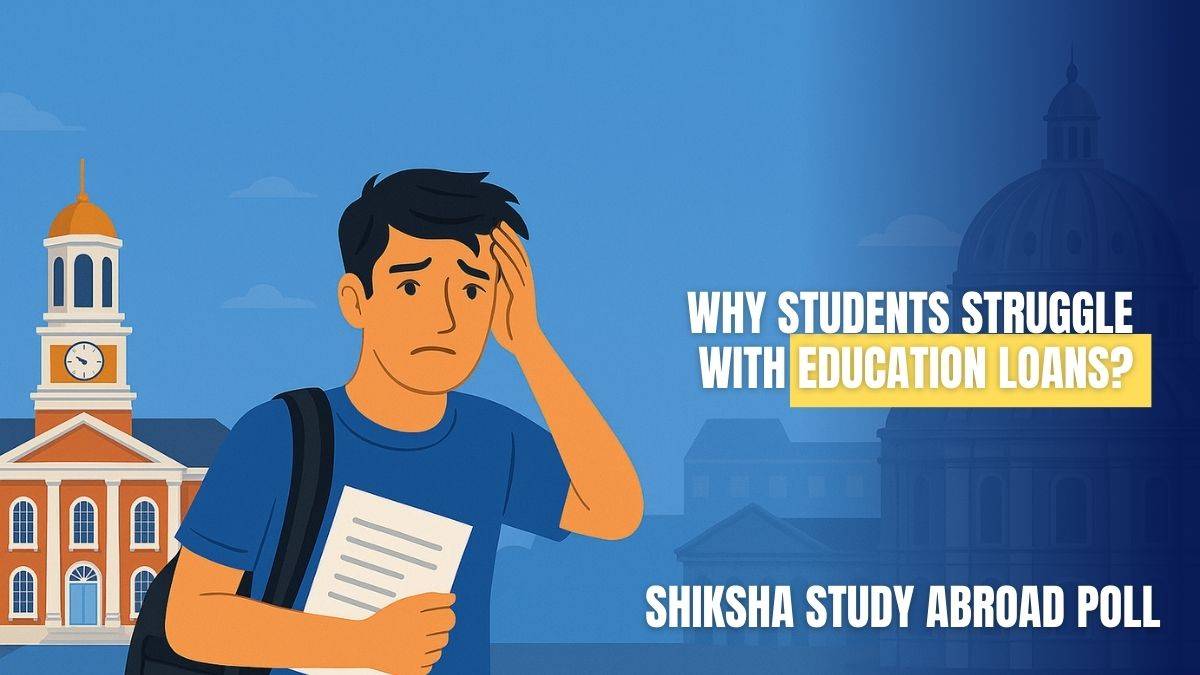What is Your Biggest Concern When Applying for an Education Loan?
Shiksha conducted a poll asking students their 'Biggest concern when applying for an education loan'. Most of the students said that a high ROI is the major reason to avoid a student loan. However, 57% of students have a different opinion on this.
The trend of studying abroad is increasing every year. Today, students from tier-2 and tier-3 cities also want to study in Canada, the USA, and other popular study destinations. The ease of getting an education loan has made this dream more accessible to these students. However, the reality is that many students are still not fully aware of the eligibility criteria and conditions for student loans.
Recently, Shiksha conducted a poll asking, “What is your biggest concern when applying for an education loan?” A total of 432 students participated in the poll. Among them, 47% mentioned that high interest rates on education loans are their biggest concern. In this article, we will cover information around the common concerns of students regarding getting an education loan for studying abroad.
Related Articles
- Poll Insights: Biggest Pain Points in Education Loan Applications
- Importance of High Interest Rates in Student Loans
- Collateral for Education Loan
- How to Improve Education Loan Approval Chances?
- Education Loan Repayment Terms: The Last Concern
Poll Insights: Biggest Pain Points in Education Loan Applications
Based on the results of the Shiksha poll, where 432 respondents voted, the majority mentioned that the expensive education loan interest rates daunt them. This is a major reason for concern and a factor that discourages them from applying for a student loan.
Here is the poll breakdown on why students avoid applying for an education loan:
| Concern |
Number of Votes |
Percentage of Votes |
|---|---|---|
| High interest rate |
203 |
47% |
| Student loan approval process |
96 |
22% |
| Collateral requirement |
91 |
21% |
| Repayment terms |
42 |
10% |
| Total |
432 |
100% |
Quick Analysis of Poll Results
- High Interest Rates: Top education loan providers in India, such as banks and NBFCs, offer loans at varying rates of interest. Majorly, the rate of interest depends on different factors. Simply, high ROI means you need to pay more during repayment.
- Collateral Requirements: Nearly, 91 respondents mentioned that banks ask for collateral against the education loan amount. Most students do not have any asset to pledge, which makes it difficult for students to borrow a study loan.
- Student Loan Approval Process: Around 96 students said that their biggest concern is the complexity of the education loan approval process. Respondents find it confusing and difficult to understand.
- Repayment Terms : Only 42 students expressed concern about the repayment terms of education loans. Their biggest concern is the future financial burden.
Importance of High Interest Rates in Student Loans
When it comes to borrowing a student loan for studying abroad, we see that the interest rates are high. Lenders often consider overseas education loans to be high-risk products, as repayment depends on the student’s future income. As a result, they offer study loans at higher interest rates. This makes the loan more expensive compared to education loans for studying within India.
Predict your IELTS, TOEFL, and PTE in just 4 steps!
Public vs Private Education Loan Providers
Students mostly prefer public sector banks to borrow education loans for their higher studies. Highly subsidized interest rates, bank concessions, and government backing are some of the major reasons behind this preference. On the other hand, private banks do not offer such schemes, but they do provide higher loan amounts to cover various expenses related to overseas education. Check out the comparison between public and private education loans below:
| Feature |
Public Sector Banks |
Private Banks / NBFCs |
| Interest Rates |
Low ROI, subsidized (especially under government schemes) |
High ROI, varies based on credit profile and institution |
| Offers Government Education Loans? |
Yes, For example: Vidya Lakshmi Portal, CGFSEL, Interest Subsidy |
No government subsidies are applicable |
| Loan Amount |
INR 50 lakhs to 1.5Cr (can vary by bank) |
Up to 3 CR, depending on profile and course of a student |
| Collateral Requirement |
Usually required for loans above INR 7.5 lakhs |
More options for unsecured (no collateral) loans |
| Processing Time |
Slower due to detailed documentation |
Faster approval and disbursal process |
| Eligibility Flexibility |
Strict academic and financial criteria |
More flexible with income and co-signer profile |
| Coverage |
Tuition + basic living expenses |
Tuition + full living expenses + travel + insurance |
Collateral for Education Loan
Banks ask for collateral against loan amount. To borrow any amount more than INR 7.5 lakhs you need to have a good profile. Otherwise, banks will ask for collateral. Some banks offer collateral free loans to candidates who have a strong academic record or get admission to top universities in the world.
How to Improve Education Loan Approval Chances?
To get the education loan approved without any issues, prepare well. Keep all required documents for education loan ready. Provide collateral documents to banks. Also, you should have a co applicant with a good credit score. If you have checked all the required tick boxes, the bank will approve your study loan within 2 to 3 weeks after your application.
Education Loan Repayment Terms: The Last Concern
Not required to mention that banks mention multiple terms and conditions at the time of approval. In the poll, only 10% of students said that repayment terms are their biggest concern, but it is still a valid point that should be addressed properly. Most banks offer a moratorium period, which means you will have 6 to 12 months after graduation to find a job and start repayment.
It is suggested to plan early using a loan amortization schedule to understand how your monthly payments will be distributed between ROI and principal. You can use education loan EMI calculators available online to understand your EMI by adjusting the loan amount, tenure, and interest rate.
Many students have less awareness about the various rules and conditions of education loans. It is a major reason, they find the student loan process difficult. If you are worried about high interest rates, explore options to secure a low-interest education loan. If the loan approval process or repayment terms are problems for you, do a well research and proper planning to ease your stress. At last, if you have voted for “collateral arrangement”, then explore for lenders that offer collateral-free education loans.
Students must know how to fill up education loans, so their applications get easy and quick approval. You can also apply for education loan through Shiksha's portal at one click.
Pick your stage and get free guidance from counsellors who've helped thousands get into top universities.
 Starting research
Starting research Shortlisting colleges
Shortlisting colleges Exam preparation
Exam preparation SOP/LOR writing
SOP/LOR writing Scholarship & finance
Scholarship & finance Visa application
Visa application


